Brief history, chocolate 101, and at home cacoa nib recipe! You can also find my mint chip energizer Erewhon smoothie dupe here.
When I was on my US book tour, I was gifted the most generous and exciting box of tropical fruit by Miami Fruit. In this dream package, there was a cacao bean! While I had seen some in stores before (Ben’s Greengrocers in London sells them), I had never splurged on buying the fruit. It really got me interested in exploring the fruit’s journey across as well as all of its different preparations - from fresh fruit to nib to chocolate bar.
I started making videos on TikTok about this cacao pod and soon realized I wasn’t the only one that was fascinated by this tropical fruit. So here I am, writing my findings to share with you all! Below you’ll find the cacao bean’s history as well as how to make cacao nibs at home.
CACAO vs. COCOA? Cacao is not processed, cocoa is.
A Brief History of Cacao
The first evidence of cacao usage comes from Mesoamerica over 5000 years ago. Although the bean was used in the culinary space, it was primarily a tool for spiritual, religious, and financial endeavors! You may have heard of Quetzalcoatl? The feathered serpent? Turns out, they believed he gifted the cacao pod to the humans so it had extreme significance.
Similar to salt in Ancient Roman times, cacao beans were used as currency and as reward for brave soldiers and their victories. They were also used in ceremonies ranging from birth rituals and baptisms to funerals.
That said, eating cacao wasn’t completely “off the table”. In the food space, cacao was not processed to make your standard chocolate bar… Far from it actually! Mesoamericans would grind the beans and add cornmeal and chili peppers to make a seemingly delicious and invigorating drink. It was considered a drink for the elite and only served at banquets or for special occasions.
In 1519, Hernan Cortes sailed across the Atlantic from Spain and visited the glorious city of Tenochtitlan. To properly host his visitor, the King prepared jugs and golden goblets filled with this special cacao drink. Obviously the Spanish were SHOOK by the new fruit they had just tasted and brought some back to Europe.
On one of their journeys, the Spanish lost their boat to the British and the latter chucked all of their cacao overboard, absolutely disgusted by the product.
Once cacao landed in Spain, the Spanish began adding in honey and sugar to help lessen the bitter flavor. It became a staple in the Spanish court and spread across the European territory. Quickly, the French, Italians, and Spanish began adding it to milk rather than water to balance out the bitterness. It was considered delicious, healthy, and also a popular aphrodisiac. There was also such cute serving ware made specifically for chocolate back then?? BRING IT BACK.


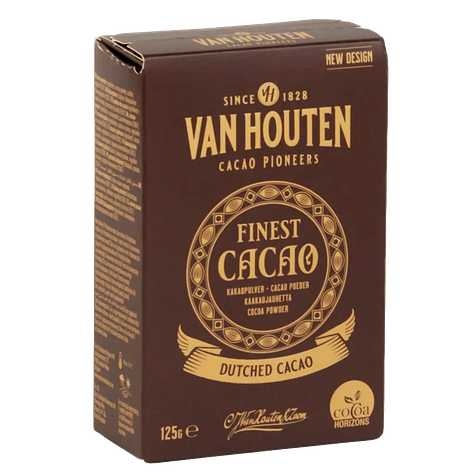
In 1828, the world was transformed when a Mr Coenraad Johannes Van Houten invented cacao press. My family is a huge fan of Van Houten cacao powder and I had no idea until writing this newsletter that he created the contraption that changed the course of food history?! Basically, this Dutch chemist built a machine which would separate the fat from the cacao resulting in cocoa powder and cocoa butter. This process removes any bitter taste from the cocoa. SO COOL.
Ever heard of Dutch process chocolate? Now you know where the name comes from!
With this press, consumers of the product could easily make hot chocolate using the powder, and also combine both the powder and butter once again to create chocolate. Further, the poor were now able to purchase this cocoa powder due to the lower price of the product. Chocolate for ALL!
Chocolate:
Dark chocolate: cocoa powder + cocoa butter + sugar
Milk chocolate: powdered milk + cocoa powder + cocoa butter + sugar
White chocolate: powdered milk + cocoa butter + sugar
The cultivation of cocoa is an extremely arduous task and required slave labor. Although back then cacao was grown in South America, once chocolate began growing in popularity, new plantations popped up in Western Africa near the equator. The demand kept rising, so they needed to come up with a solution and this similar terroir proved fruitful.
Nowadays, chocolate cultivation still occurs in both areas. Unfortunately, indentured servitude, child labor, and other human rights abuses are still very prevalent in the world of cacao farming. Next time you reach for a bar of chocolate, make sure you know where your chocolate is coming from! It’s always worth spending that extra money and knowing that you haven’t contributed to the abuses associated with cacao farming.
Recipe: Cocao Nibs
I will never complain about cacao nib prices ever again after this process. Although I could have taken it a step further and made a bar of chocolate, I honestly LOVE the flavor of a bitter nib and will reach for a cacao nib over a chocolate chip any day.
*it’s cocao not cacoa nib because the nib is roasted! if we had dried these in the sun, it would be a cacao nib.
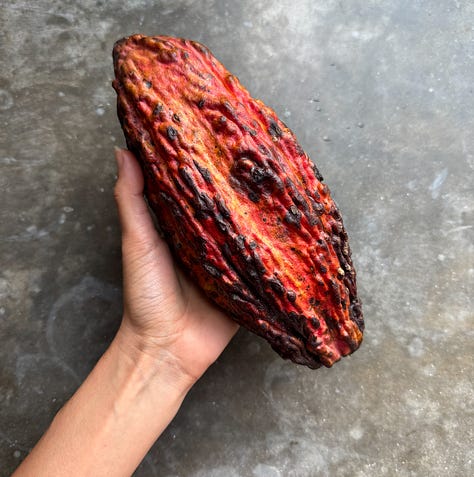
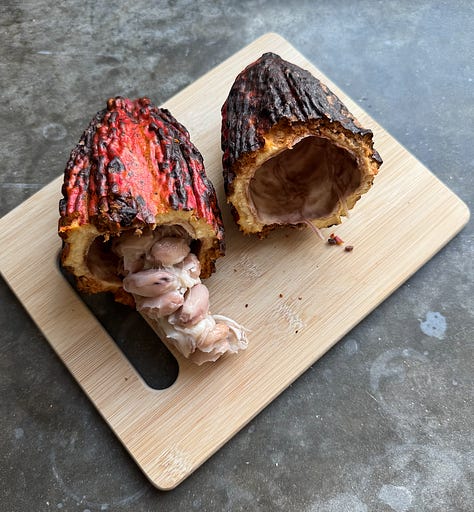
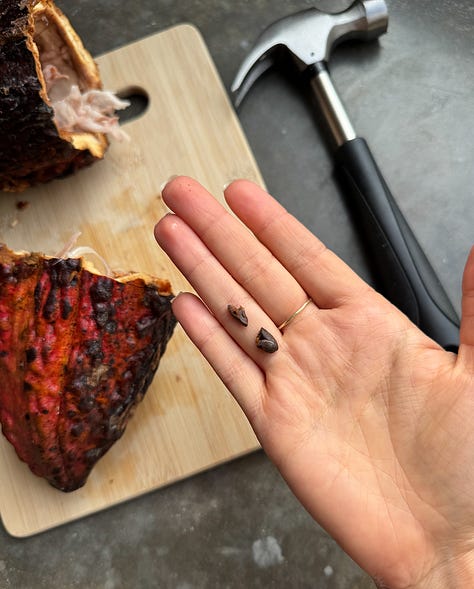
All you need is 1 cacao pod, a jar, and an oven.
Day 1: crack your pod open and separate your beans. Place these in a jar and add some cheesecloth on top. You’ll leave this jar on your counter for the beans to ferment.
Taste the fruit! It has a really tropical flavor, somewhat similar mango, litchi and soursop but will a slimy texture like that of a litchi. It’s particular but I enjoyed it!
Day 2-5: stir your beans daily to make sure they don’t rot! You’ll definitely smell the fermentation process… If it’s really hot out, these can ferment quickly (which happened to me).
Day 5 (or sooner): Once your beans are fermented, place them on a baking tray and roast at 115C for 30 minutes. They should be nice and dry, and much darker in color. Let them cool then peel the skin off. There you go! You’ve got cocao nibs!

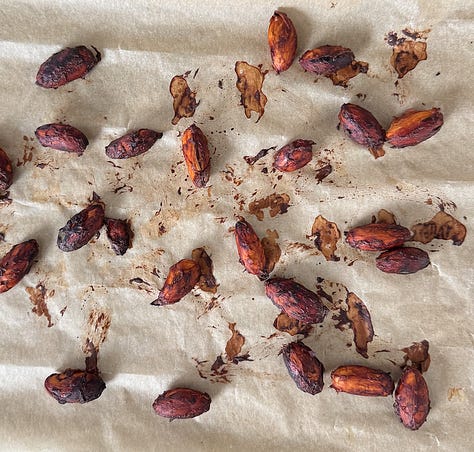
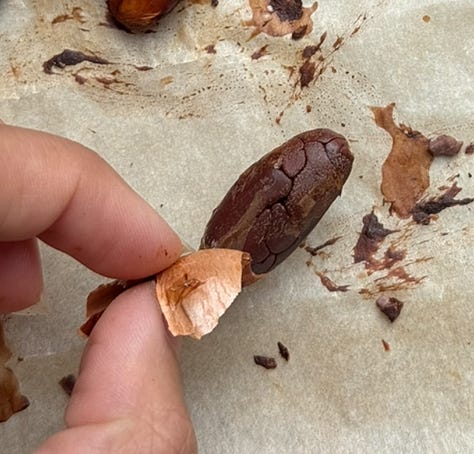
Optional: I ended up leaving my nibs to air dry for the rest day and then roasted them again at 150C for 5 minutes the following day. This gave me an extra roasty, slightly sweeter and chestnutty flavor. I am not a chocolate expert whatsoever so you do you but I’m just telling you exactly what I did!
Use these nibs however you’d like - my current preference is in a yogurt bowl, a mint chip shake, or in my classic valentines day jam!
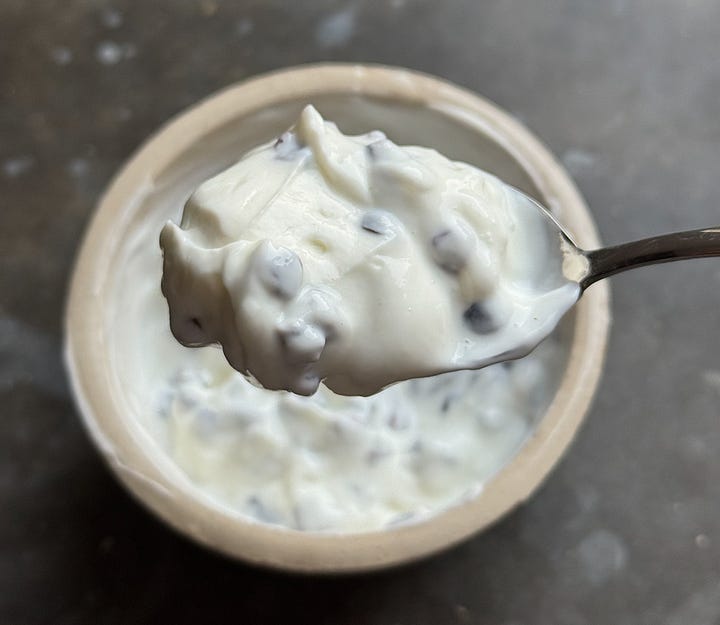
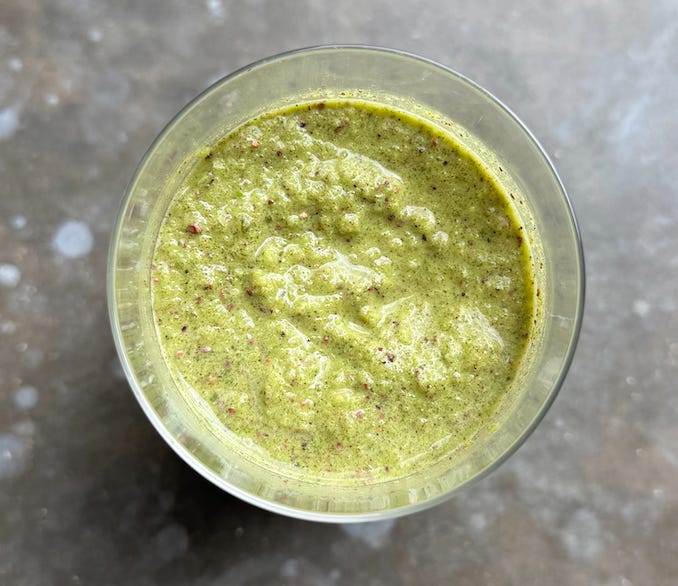

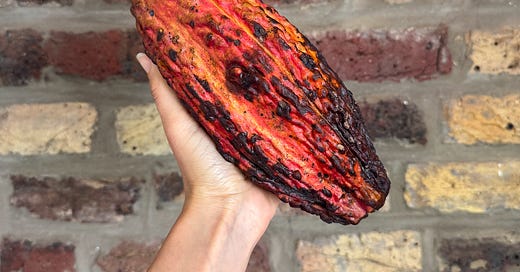








This looks so yummy
Thanks for this, so fun to learn! And so important to know more about specialty foods like this that are so widely accessible now. Definitely worth the investment :)